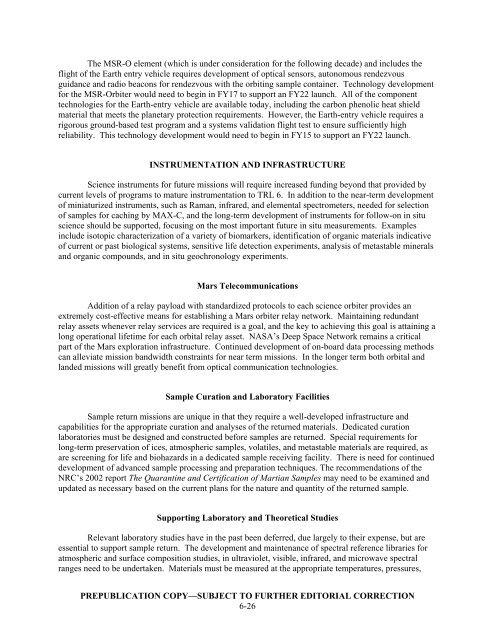Vision and Voyages for Planetary Science in the - Solar System ...
Vision and Voyages for Planetary Science in the - Solar System ...
Vision and Voyages for Planetary Science in the - Solar System ...
You also want an ePaper? Increase the reach of your titles
YUMPU automatically turns print PDFs into web optimized ePapers that Google loves.
The MSR-O element (which is under consideration <strong>for</strong> <strong>the</strong> follow<strong>in</strong>g decade) <strong>and</strong> <strong>in</strong>cludes <strong>the</strong><br />
flight of <strong>the</strong> Earth entry vehicle requires development of optical sensors, autonomous rendezvous<br />
guidance <strong>and</strong> radio beacons <strong>for</strong> rendezvous with <strong>the</strong> orbit<strong>in</strong>g sample conta<strong>in</strong>er. Technology development<br />
<strong>for</strong> <strong>the</strong> MSR-Orbiter would need to beg<strong>in</strong> <strong>in</strong> FY17 to support an FY22 launch. All of <strong>the</strong> component<br />
technologies <strong>for</strong> <strong>the</strong> Earth-entry vehicle are available today, <strong>in</strong>clud<strong>in</strong>g <strong>the</strong> carbon phenolic heat shield<br />
material that meets <strong>the</strong> planetary protection requirements. However, <strong>the</strong> Earth-entry vehicle requires a<br />
rigorous ground-based test program <strong>and</strong> a systems validation flight test to ensure sufficiently high<br />
reliability. This technology development would need to beg<strong>in</strong> <strong>in</strong> FY15 to support an FY22 launch.<br />
INSTRUMENTATION AND INFRASTRUCTURE<br />
<strong>Science</strong> <strong>in</strong>struments <strong>for</strong> future missions will require <strong>in</strong>creased fund<strong>in</strong>g beyond that provided by<br />
current levels of programs to mature <strong>in</strong>strumentation to TRL 6. In addition to <strong>the</strong> near-term development<br />
of m<strong>in</strong>iaturized <strong>in</strong>struments, such as Raman, <strong>in</strong>frared, <strong>and</strong> elemental spectrometers, needed <strong>for</strong> selection<br />
of samples <strong>for</strong> cach<strong>in</strong>g by MAX-C, <strong>and</strong> <strong>the</strong> long-term development of <strong>in</strong>struments <strong>for</strong> follow-on <strong>in</strong> situ<br />
science should be supported, focus<strong>in</strong>g on <strong>the</strong> most important future <strong>in</strong> situ measurements. Examples<br />
<strong>in</strong>clude isotopic characterization of a variety of biomarkers, identification of organic materials <strong>in</strong>dicative<br />
of current or past biological systems, sensitive life detection experiments, analysis of metastable m<strong>in</strong>erals<br />
<strong>and</strong> organic compounds, <strong>and</strong> <strong>in</strong> situ geochronology experiments.<br />
Mars Telecommunications<br />
Addition of a relay payload with st<strong>and</strong>ardized protocols to each science orbiter provides an<br />
extremely cost-effective means <strong>for</strong> establish<strong>in</strong>g a Mars orbiter relay network. Ma<strong>in</strong>ta<strong>in</strong><strong>in</strong>g redundant<br />
relay assets whenever relay services are required is a goal, <strong>and</strong> <strong>the</strong> key to achiev<strong>in</strong>g this goal is atta<strong>in</strong><strong>in</strong>g a<br />
long operational lifetime <strong>for</strong> each orbital relay asset. NASA’s Deep Space Network rema<strong>in</strong>s a critical<br />
part of <strong>the</strong> Mars exploration <strong>in</strong>frastructure. Cont<strong>in</strong>ued development of on-board data process<strong>in</strong>g methods<br />
can alleviate mission b<strong>and</strong>width constra<strong>in</strong>ts <strong>for</strong> near term missions. In <strong>the</strong> longer term both orbital <strong>and</strong><br />
l<strong>and</strong>ed missions will greatly benefit from optical communication technologies.<br />
Sample Curation <strong>and</strong> Laboratory Facilities<br />
Sample return missions are unique <strong>in</strong> that <strong>the</strong>y require a well-developed <strong>in</strong>frastructure <strong>and</strong><br />
capabilities <strong>for</strong> <strong>the</strong> appropriate curation <strong>and</strong> analyses of <strong>the</strong> returned materials. Dedicated curation<br />
laboratories must be designed <strong>and</strong> constructed be<strong>for</strong>e samples are returned. Special requirements <strong>for</strong><br />
long-term preservation of ices, atmospheric samples, volatiles, <strong>and</strong> metastable materials are required, as<br />
are screen<strong>in</strong>g <strong>for</strong> life <strong>and</strong> biohazards <strong>in</strong> a dedicated sample receiv<strong>in</strong>g facility. There is need <strong>for</strong> cont<strong>in</strong>ued<br />
development of advanced sample process<strong>in</strong>g <strong>and</strong> preparation techniques. The recommendations of <strong>the</strong><br />
NRC’s 2002 report The Quarant<strong>in</strong>e <strong>and</strong> Certification of Martian Samples may need to be exam<strong>in</strong>ed <strong>and</strong><br />
updated as necessary based on <strong>the</strong> current plans <strong>for</strong> <strong>the</strong> nature <strong>and</strong> quantity of <strong>the</strong> returned sample.<br />
Support<strong>in</strong>g Laboratory <strong>and</strong> Theoretical Studies<br />
Relevant laboratory studies have <strong>in</strong> <strong>the</strong> past been deferred, due largely to <strong>the</strong>ir expense, but are<br />
essential to support sample return. The development <strong>and</strong> ma<strong>in</strong>tenance of spectral reference libraries <strong>for</strong><br />
atmospheric <strong>and</strong> surface composition studies, <strong>in</strong> ultraviolet, visible, <strong>in</strong>frared, <strong>and</strong> microwave spectral<br />
ranges need to be undertaken. Materials must be measured at <strong>the</strong> appropriate temperatures, pressures,<br />
PREPUBLICATION COPY—SUBJECT TO FURTHER EDITORIAL CORRECTION<br />
6-26











